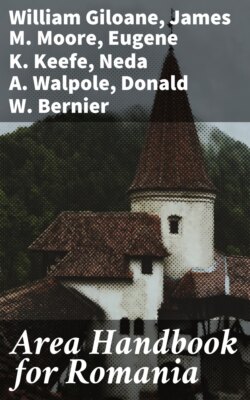Читать книгу Area Handbook for Romania - Eugene K. Keefe - Страница 9
На сайте Литреса книга снята с продажи.
CHAPTER 2 HISTORICAL SETTING
ОглавлениеTable of Contents
Romania's history as an independent state dates from about the middle of the nineteenth century; as a communist state, from about the end of World War II. The history of the Romanian people, however, is long, complex, and important when considered in the context of the overall history of the Balkan region. The origin and development of the Romanians remain controversial subjects among Romanian and Hungarian historians, whose arguments serve to support or deny claims to rightful ownership of large areas within Romania's borders (see fig. 1).
Until the end of World War II Romania's history as a state was one of gains and losses of territory and shifting borders. As the Ottoman Empire in Europe receded, the Romanians found themselves pressured by the Russian and Austro-Hungarian empires. Borders arranged by the victorious powers after World War I increased Romania's territory but also increased its minority population, particularly the Hungarian. Between the two world wars the country experienced a period of fascist dictatorship and aligned itself with Nazi Germany early in World War II, but it eventually overthrew the fascists and finished the war on the side of the Allies.
The borders arranged after World War II formalized the loss of territory to the Soviet Union but have remained stable since the end of the war. In the postwar chaos of the late 1940s, with Soviet troops occupying the country, Romania deposed its king and emerged as a communist state under the close scrutiny and supervision of its powerful northern neighbor, the Soviet Union. After the death of Josef Stalin the Romanian leadership began a slow pursuit of nationalist goals, which continued in the early 1970s. Although the Moscow-Bucharest ties have often been strained, the Romanians have carefully avoided a break that would provoke a reaction such as the Soviet-led invasion of Czechoslovakia in 1968.
The Romanian people see themselves as a Latin island surrounded by Slavs and Magyars (Hungarians). They are proud of their long, distinctly different historical development and consider that their history is important to them as proof of their ethnic uniqueness in the area and as proof that Romania belongs to the Romanians.
EARLY ORIGIN
The earliest recorded inhabitants of the area included in present-day Romania were Thracian tribes, known as Dacians, who settled in the area well before the Christian Era and established a major center in Transylvania (see fig. 2). These people practiced a primitive form of agriculture and engaged in limited trade with Greek settlements along the western coast of the Black Sea. By the middle of the first century A.D. the Dacians had grouped themselves into a loosely formed state ruled by a series of kings who attempted to expand their power to the north and west and, most aggressively, to the south into the area below the lower Danube River.
